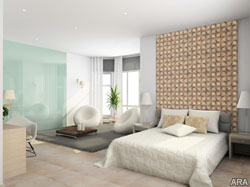
(ARA) – Ceramic tile has held a hallowed place in bathroom renovations for generations. Durable, easy to clean, and available in a wide range of color, format and design, tile just makes sense in a bath. But some enterprising designers and homeowners are finding a new spot in the home where tile not only works well, but can take center stage – the master bedroom.
Homeowners are choosing to incorporate ceramic tiles into master bedrooms for many of the same reasons the material has been popular in bathrooms and kitchens:
* Tile is more durable than other materials, lasting up to four times longer than carpet or wood. Unlike wood, it will never need refinishing, restaining or sanding. It holds its luster better than vinyl, and requires no special chemical treatments, the way many natural stone products do. Because of this easy maintenance and durability, consumers can realize lower costs over the life of the product.
* It’s naturally hypoallergenic and releases no volatile organic compounds (VOCs) into the atmosphere. It doesn’t collect dust, dust mites, pet dander or other irritants and microbes.
* Tile is readily available in a wide range of colors, sizes, shapes and design themes. In fact, you can now find ceramic tile that even mimics the look of other popular, more costly or less durable materials like wood, glass or even metal.
So how can you use tile in your master bedroom? Tile of Spain branded manufacturers cite several trends in ceramic tile’s use in master bedrooms:
To create a headboard
Fabric, wood or metal headboards can make a powerful design statement, and solidify a bed’s stance as the centerpiece of a room. Ceramic tile, now available in large formats and in designs that mimic the look of other materials, is a sensible, cost-effective and healthier alternative to some popular headboard materials. Creating a fabric headboard, for example, can be a costly, time-consuming process, yet you can get virtually the same look with ceramic tile made to look like fabric. And this is fabric that won’t harbor germs and microbes.
General design touches
If you love the look of wainscoting, wood paneling or bead board, but prefer a more durable, hypoallergenic material, ceramic tile can offer the same look without the disadvantages of wood decorator touches. Several Tile of Spain branded manufacturers produce tiles that look like wood design elements.
Extending the life of a paint job
Paint is one of the easiest things to change in a room and can be one of the most difficult to clean and preserve. One way to extend the life of a paint job is to tile walls to the level of the chair rail – the portion of the walls that gets the most exposure to unsightly dirt, dings and scuffs. While some paints may require special cleaning solvents to remove dirt without damaging the finish, tile requires nothing more than hot water and some elbow grease.
Creating cohesion between rooms
In master suites with large, open floor plans, using tile in the bedroom portion of the suite can help create a seamless transition between the sleeping and bathing areas. Or, it can help create cohesion between indoor and outdoor spaces – tile is one of the few interior design materials that can flow from inside to out.
Achieving a look with added durability
You may love the look of hardwood, but know that wood doesn’t hold up well in rooms where it’s exposed to a lot of moisture on a daily basis – such as in a bathroom – or to a lot of wear and tear, such as in a bedroom. While wood that’s exposed to water will eventually warp and wear, ceramic tile designed to look like prized hardwoods will stand up to moisture and water – even if the bathtub overflows. And ceramic tile that looks like wood will never develop the “worn path” appearance of wood that bears heavy foot traffic.
When it comes to interior design, sometimes the unexpected makes perfect sense – such as finding creative ways to use ceramic tile in the master bedroom. You can learn more about ceramic tile and tile trends at www.spaintiles.info.
Courtesy of ARAcontent





